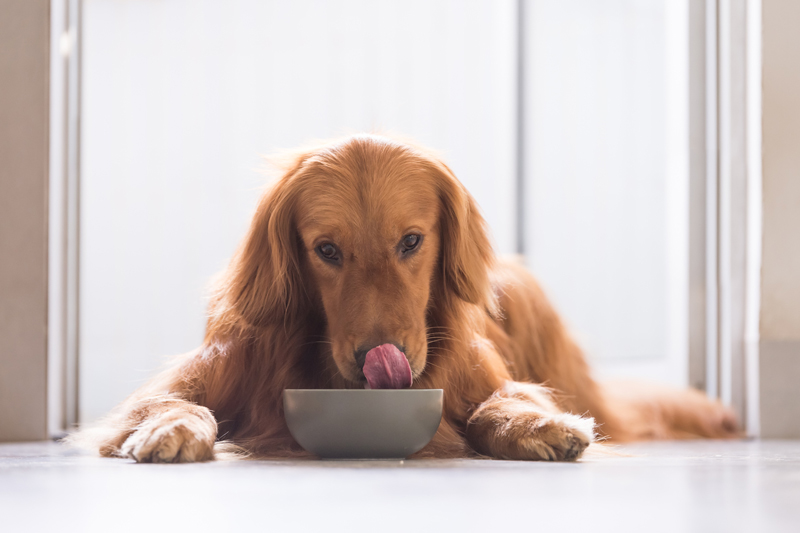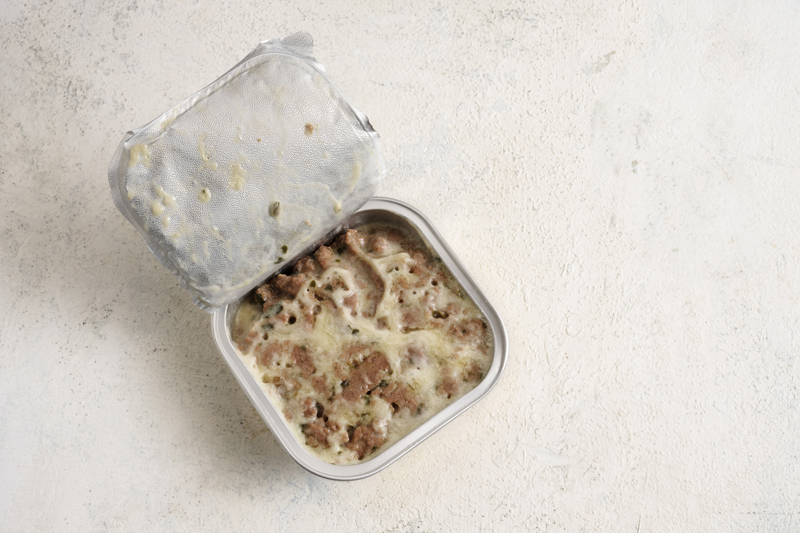What’s a dog to eat? They’d probably answer “everything!” After all, dogs seem to enjoy eating grass, crumbs off the floor, pine cones — they’re not particular.
But you, responsible human, have probably decided to go a better route. If you’re considering canned (wet) food as the primary food for your dog, there’s some great positives, as well as a handful of drawbacks, to think about.
Benefits of canned food
Dogs love wet food
All right, dogs love most food. But if your pooch is a fussy eater and always looking put off by its dinner or picking at its meal, wet food might be just what it needs to polish off its dish.
Wet food has a pungent smell, and it more closely resembles the meat that it is than dry food does. Oftentimes, canned food can lure a particular or disgruntled eater into munching.
The strong smell can also lure senior dogs that may be struggling with a decreased sense of smell.

Wet food has a high moisture content
Unlike kibble, which gets most of the moisture sucked out of it during manufacturing, wet food comes loaded with moisture both from the ingredients and water added during the canning process.
If your dog is typically dehydrated, this is a way to get some water into your pet.
The moisture content can also help your dog avoid urinary tract infections.
Canned food may have higher protein than dry food
Adult dogs need a minimum of 18 percent crude protein in their daily meals. This applies no matter what type of dog food brand or type of food you’re buying. Some exceptions apply: some health issues may mean your dog needs a lower protein diet.
The amount of protein in wet food varies from brand to brand and formulation to formulation, so you need to read labels to make sure your canned food does in fact have more protein than another food.
To compare protein amounts between wet and dry food, you need to calculate the dry matter in wet food and compare it to the dry matter in dry food. Homes Alive Pets has a simple calculator to help determine the dry matter protein content.
Wet food is easy to eat
Dogs with poor dental health or dogs that are recovering from mouth surgery will appreciate the soft, easy to eat texture of canned food. It’s not crunchy and provides relief instead of pain while chewing. Teething puppies can also easily eat wet food.
Senior dogs can suffer from teeth or gum issues. Some senior dogs have missing teeth and may have a hard time chewing a dry, crunchy food. Wet food is soft and palatable.
Wet food is easy to digest
Canned food often has a smooth, canned food texture. Your dog doesn’t have to chew as much to break it down, which is good news for glupers or dogs that have chronic indigestion.
If your dog has been sick or is experiencing gastrointestinal upset, try canned food and see if that helps.
Canned food may reduce the risk of bloat
Dogs that eat dry food may immediately drink a lot of water, which causes the food to expand in their stomach.
This may lead to a serious condition called bloat. Dogs that gulp their food down are also at a higher risk of bloat because they swallow more air as they eat.
Vets don’t know exactly what causes bloat, but it happens when a dog’s tummy fills with gas, food or fluid and causes it to expand. Sometimes, a dog’s stomach will rotate or twist. It’s a very serious, life threatening condition.
Large, deep chested dogs are more prone to bloat then other dogs, but any dog theoretically can get bloat.
Early symptoms of bloat are:
 restlessness
restlessness- drool
- a swollen stomach
- attempts to vomit
- pacing
- stretching and unable to get comfortable
- looking anxious
Wet food doesn’t expand and your dog probably won’t nose dive into its water bowl after eating it. Eating food from a raised bowl, eating quickly, having one large meal a day, and eating or drinking too much can also lead to bloat, according to Fetch by WebMD.
Drawbacks to wet food
Cans may contain unwanted toxins
Bisphenol A (BPA) is a endocrine-disrupting chemical that may be found inside food cans.
“BPA is an industrial chemical that has been used to make certain plastics and resins since the 1960s,” according to the Mayo Clinic. “BPA is found in polycarbonate plastics and epoxy resins. Polycarbonate plastics are often used in containers that store food and beverages, such as water bottles.”
These epoxy resins are sometimes used to coat the inside of food cans.
In 2016 the University of Missouri did a short term study about BPA exposure to dogs.
“Researchers … have found that the short-term feeding of canned dog food resulted in an significant increase in BPA in dogs,” a university news release from Dec. 19, 2016 states.
Healthy dogs were used in the study and the researchers collected blood and fecal samples before the dogs were given two types of commercial canned food diets for two weeks. The study found that BPA in the dogs’ blood increased by nearly three times after the dogs were on the canned diet, and that the dogs had changes in their gut microbiome.
More and more manufacturers are using cans that are marked BPA free, so if you’re concerned try to find a brand that uses BPA free cans.
The U.S. Food & Drug Administration allows BPA to be used in food containers and packaging, but it has been banned from being used in baby bottles.

Wet food needs storage space
Canned food takes up a lot of space! Especially if you have a big dog eating a couple of cans a day. You’ll need to stock up and make sure you have enough food to last you before your next purchase.
Wet food can be pricey
For small and medium sized dogs, wet food is a more affordable option than if you have a large dog needing a big meals. Wet food is not generally as cost effective as dry kibble and it doesn’t go as far.
Your big dog may not get enough calorie density as easily
“A large dog may have a hard time meeting his or her energy needs on canned food alone,” according to DogHealth.com. “This is because dry food is usually about 10% water as compared with about 75% water in canned rations.”
Dry food enables dogs to ingest lots of calories in lower quantities. Dogs may need to eat two or three times as much wet food to get the same caloric intake. However, many of the calories in dry food come from grains or carbs.
Wet food is messier
Most dogs aren’t known for their table manners. If your dog spills some kibble or dehydrated food on the floor while it’s eating, it’s pretty to clean it up (assuming your pooch doesn’t do it for you). Wet food, well, that’s going to require a damp cloth.
Wet food has to be refrigerated
Dry food storage is simple. You can keep it sealed in a plastic container in a cupboard and it stays good for months. Wet food, once opened, has to be refrigerated to prevent bacterial growth. It also needs to be sealed properly so that odors don’t escape and fill your fridge.
Most wet foods only last up to seven days in the fridge, so you have to make sure you use it and it doesn’t go to waste. Alternatively, you can freeze portions, which means more work for you.






